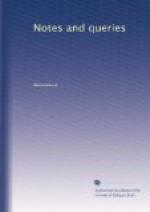C.
* * * * *
Sapcote Motto (No. 23. p. 366.).—This motto is known to be French, and as far as it can be decyphered is—
“sco toot X vinic [or umic]
X pones,”
the first and last letters s being possibly flourishes. This certainly seems unpromising enough. The name being Sapcote, quasi Sub-cote, and the arms “three dove-cotes,” I venture to conjecture “Sous cote unissons,” as not very far from the letters given. If it be objected that the word “cote” is not in use in this sense, it may be remarked that French, “After the scole of Stratford atte bowe,” might borrow such a meaning to suit the sound, from “cote,” in the sense of a side or declivity. And if the objection is fatal to the conjecture, I would then propose “Sous toit unissons.” If we reject the supposed flourishes at the beginning and ending of the inscription, and take it to be—
CO TOOT VNIC
CONC,
the c being a well-known ancient form of s, there is a difference of only one letter between the inscription as decyphered and the proposed motto.
If either of these is adopted, the sentiment of family union and family gathering, “As doves to their windows,” is well adapted for a family device.
T.C.
Durham, May 2. 1850.
* * * * *
Finkle or Finkel (No. 24. p. 384.).—Is not “Finkle” very probably derived from Finc, a finch, in the A.-S.? Fingle Bridge, which spans the river Teign, amidst some most romantic scenery, has the following etymology assigned to it by a local antiquary, W.T.P. Short, Esq. (vide Essay on Druidical Remains in Devon, p. 26.): “Fyn, a terminus or boundary; and Gelli, hazel, the hazeltree limits or boundary.” But, Query, is not the second syllable rather Gill, akin to the numerous tribe of “gills” or “ghylls,” in the North Countrie?
J.M.B.
* * * * *
Meaning of Finkle.—Referring to No. 24. p. 384. of your most welcome and useful publication, will you allow me to say, touching the inquiry as to the derivation and meaning of the word “Finkle” or “Finkel” as applied to a street, that the Danish word “Vincle” applied to an angle or corner, is perhaps a more satisfactory derivation than “fynkylsede, feniculum,” the meaning suggested by your correspondent “L.” in No. 26. p. 419. It is in towns where there are traces of Danish occupation that a “Finkle Street” is found; at least many of the northern towns which have a street so designated were inhabited by the Danish people, and some of those streets are winding or angular. Finchale, a place, as you know, of fame in monastic annals, is a green secluded spot, half insulated by a bend of the river Wear; and Godric’s Garth, the adjacent locality of the hermitage of its famous saint, is of an angular form. But then the place is mentioned, by the name of Finchale, as the scene of occurrences that long preceded the coming of the Danes; and the second syllable may be derived from the Saxon “alh” or “healh,” as the place was distinguished for a building there in Saxon times.




